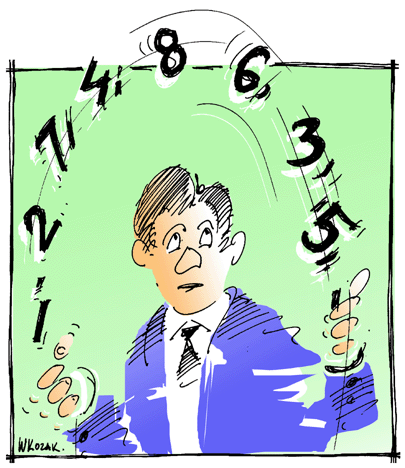By TheGraveMind
People at work have been making fun of me being on the calculator so much. I'm always running numbers, adding up lists and figuring out the odds. I often run the probability of doing damage from unit to unit. It helps give a good idea how much fire power on average you'll need to take another unit down. Here I'll run through a few scenarios to give a little step by step.
Lets start simple. Something a lot of people learn playing this game.
Odds of a 6+ is 1/6 = 16.66%
So 5+ is 2/6 so 33.33%
4+ is 50%
3+ is 66.66%
2+ is 83.33%
So that covers simple shooting, but what happens when you get to reroll?
Hitting on 6+ gives you 16.66% + 13.33%. How did I get the 13.3%? The chance of success is 1/6, while the chance of failure is 5/6. We only care about the reroll when we fail, so you have a 1/6 chance out of the 5/6 chance. 5/6 is 83.3% and 16.6% of that is 13.3%.
So we get a total of 29.9% of success with 6+ reroll.
Taking that with the rest gives us this.
5+ reroll = 33.3% + (66.6% failure x 33.3% = 22.2%) so 55.5%
4+ reroll = 50% + 25% = 75%
3+ reroll = 66.6% + 22.2% = 88.8%
2+ reroll = 96.6%
So you see, you have to consider the chance of failure and success when you add any steps in addition to the first roll. Lets take these leasons then and apply them to something a bit more advanced in game.
Let's say you're running a Deathstar or some power unit that depends on you getting some good psychic powers. Say you're aiming for invisibility, how about we figure out the odds of getting the power you want.
So your first roll you have a 1/6 chance of getting the power you wanted. That's 16.6% as we know. How about the second roll. Well the rule applies, you are no long just rolling 1 die, so you need to consider both success and failure. You have a 5/6 chance of not getting the power.
On your second roll, you can't get the first power again, so you have a 1/5 chance left. If we multiply that out you get 5/6 x 1/5, the fives cancel out and you're left with 1/6 again. So each Mastery Level gives you a 16.6% chance of getting the power you want.
But now we have Tigurius, who not only has three rolls, but can reroll them.
Well it runs very similar to normal rerolls, expecially if you consider each power gives you 16.6%.
1/6 success + (5/6 failur x 1/6 success) = 29.9%
Chance of failure from the first roll then is (100%-29.9%) =70%
So (1/5 Success + [4/5 x 1/5]) = 36% chance of the second roll getting the power you want. To get to that second roll, you have to fail, so 36% x 70% = 25.5% Add this to the first roll and so far you have a 55.5% chance. Looks a lot like the normal reroll odds we did near the start.
(100-55.5%) x (1/4 + [3/4 x 1/4]) Gives you a 44.4% x 43.75% = 19.5% on the third roll. Adding this in, gives a grand total of 75%.
Now ML3 is the limit of Tiggy and his reroll powers, but for the sake of knowing, I ran the numbers out for ML4 and ML5. They are 88% and 96%, just like normal rerolls.
This makes sense since rolling for powers seems to follow the statistics of normal shooting odds. So all this fancy rules for Tiggy with his three chances for a power, each with a reroll actually has the same simple odds of hitting with a twin linked weapon, just a lot more math behind it if you dig deep enough.
So just something to take away, Tiggurius has a 75% chance of getting what ever power you want from a discipline, assuming you keep trying for it, and don't default to the primaris, as that essentially takes away one set of rolls.
A normal psyker has a 16.6% per Master level of getting a power.
This was a glance at the workings of Math hammer that can help influence decisions you make while playing the game, I hope I kept it easy enough to follow and not too boring. Let me know if I skipped over a step, or if you have any requests.
TL:DR Math's hard



Good topic! I also like to run through some basic number crunching to get an idea of what a typical result might be.
ReplyDeleteI'm trying to get better at allowing for above or below average results by overlapping threats and targets to try and have backup units (for below average) and alternative targets (for above average). Not quite sure about the figures for the different levels of standard deviation, but I guess I'm trying to work to the first and take anything more as a risk? It's been a while!
Anyway, very handy article and good food for thought!
For Tig you don't have to re roll them straight away. So you could roll 3 dice on to get the power you want then re roll one at a time so your re roll has a 1/4 chance of getting the power you want. I don't know what the maths is on that but significatly better then 75%
ReplyDelete